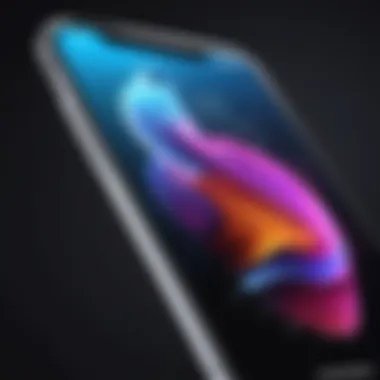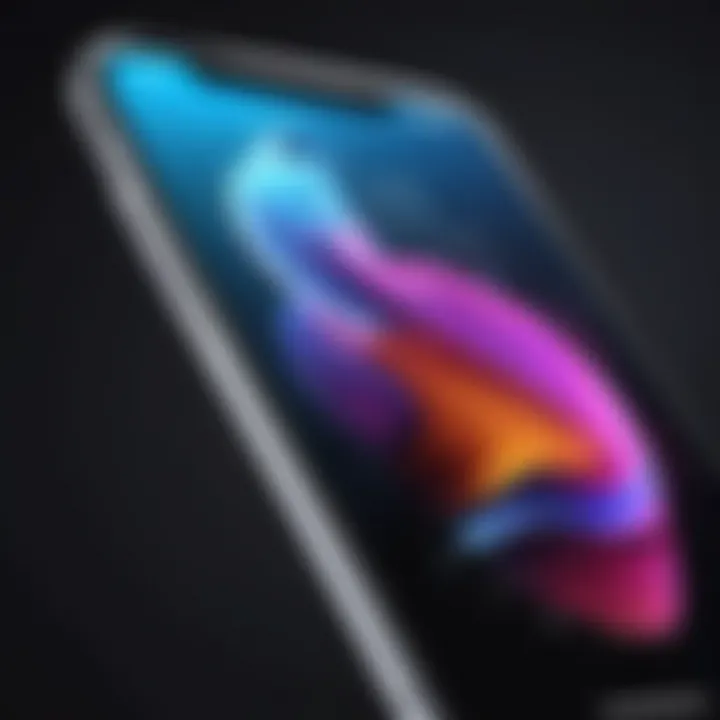Mastering Image Overlays on Your iPhone


Intro
In today's visually-driven world, overlaying images on an iPhone is a crucial skill for many. Whether for personal use or professional endeavors, this technique allows individuals to create dynamic visuals that stand out. A variety of methods exist within the iOS ecosystem itself, and numerous third-party applications can enhance the user experience. This guide aims to decipher the methods for overlaying images, ranging from basic techniques to advanced applications, enabling users to elevate their photo editing repertoire.
Overview of the Technology
Overlaying images involves merging two or more photos into one. The technology behind this encompasses both hardware and software capabilities unique to iPhones.
Key specifications
The iPhone's camera systems are equipped with advanced sensors that capture high-resolution images. Devices like the iPhone 14 Pro feature multiple lenses, which provide versatility in capturing different perspectives.
Furthermore, the processing capabilities of Apple's A-series chips enhance image processing speed and quality. This allows users to apply effects seamlessly, making the overlaying process more efficient.
Unique selling points
What sets iPhones apart in the realm of photo editing?
- User-friendly interface: iOS apps are designed for intuitive navigation.
- Integration with iCloud: Easy access to images across devices helps streamline the editing process.
- Rich ecosystem of apps: Availability of professional editing tools alongside casual applications provides options for every user level.
Prelude
In an increasingly image-centric world, the ability to overlay images on an iPhone has become a sought-after skill among tech-savvy individuals and aspiring photographers. This functionality is not just a creative tool; it serves practical purposes as well. Image overlays can enhance visual storytelling, aid in advertising, or simply elevate standard photos into something more engaging. Whether for social media or professional projects, understanding how to manipulate images effectively can set one apart in the crowded digital landscape.
With numerous applications available, both built-in and third-party, users have a variety of options to explore. This comprehensive guide will delve into the practical steps necessary to overlay images on your iPhone, examining native tools and specialized apps. We will discuss the nuances of image quality, layering techniques, and best practices for producing aesthetically coherent visuals. Each element plays a crucial role, contributing to a polished final product.
Ultimately, mastering image overlays will empower users to express their creativity. It allows for the customization of photos, making them unique and tailored to specific audiences or purposes. As we navigate through the guide, we will uncover not only the technical skills required but also identify the mindset needed for effective visual communication.
By honing these techniques, you will gain confidence in your photo editing abilities, enhancing both personal and professional projects. The journey toward mastering image overlays can be both insightful and rewarding, unlocking new potentials for personal expression and marketability.
Understanding Image Overlays
Image overlays are a fundamental concept in the domain of digital photography and graphic design. They involve placing one image over another, allowing for a blend of visual elements to create more dynamic and engaging visual content. This technique can significantly enhance the aesthetic appeal of images.
Understanding how to overlay images is crucial because it opens doors to creative expression. Whether you are a casual user looking to personalize your photos or a professional in the field of design, mastering this skill can elevate your work. The benefits of utilizing image overlays include the ability to showcase multiple perspectives in a single image, highlight important features, or create impactful visuals that convey a specific message.
Additionally, considerations such as layering order, transparency levels, and image quality become essential when working with overlays. Each aspect contributes to the overall impact of the final image. By exploring the nuances of image overlays, readers can learn to critically analyze their images and context, leading to more effective communication through visuals.
Definition of Image Overlay
An image overlay refers to the process of superimposing one image onto another. This can be done in various ways, and the effect can range from subtle to striking. When overlaying an image, the top image can often be adjusted for opacity, allowing the underlying image to show through. This flexibility allows for creative combinations that can tell a story or enhance the viewer's experience.
In practical terms, image overlays can be achieved through various software and apps on the iPhone, both native and third-party applications. Users can manipulate these images through resizing, rotating, and adjusting colors, all of which contribute to the finished product.
Common Uses for Image Overlays
Image overlays find numerous applications across different fields. Some of the most common uses include:
- Social Media Posts: Users frequently overlay text or graphics on images to create eye-catching posts for platforms like Instagram and Facebook.
- Marketing Materials: Businesses leverage image overlays for product promotions, often combining images with logos or special offers to attract customers.
- Personalizing Photos: Individuals may want to add personal touches to their photos, such as quotes or decorative elements, to make them more meaningful.
- Artistic Expressions: Artists utilize overlays to create unique artworks that blend various textures and imagery to convey deeper themes.
Through these applications, the power of image overlays becomes evident. They allow users to tap into their creativity and communicate messages visually, making this topic integral to anyone aiming to improve their photo editing capabilities.
Native iOS Options for Image Overlay
Native iOS options for image overlay provide a straightforward and user-friendly method for those who want to enhance their photos without needing to download additional applications. Users can leverage the built-in features of their iPhones effectively, making these tools a popular choice. The availability of such features means that anyone with an iPhone can create visually appealing images with minimal effort and understanding of complex software. Beyond accessibility, native options ensure that users maintain quality and security, as they rely on the operating system's inherent functionalities.
Using the Photos App
Steps to Access the Photos App
To begin using the Photos app for image overlays, simply tap on the Photos icon on your iPhone's home screen. The app opens to display your albums and a timeline of your images. This accessibility plays a significant part in the photo editing process. A user can quickly pull up their desired images without engaging with third-party applications.
The intuitiveness of the Photos app is a key characteristic. Many users find it familiar due to its everyday usage. This familiarity allows individuals to navigate the app effortlessly, making it a beneficial option for layering images.
Moreover, you can organize images into albums for easier selection. One unique advantage of the Photos app is its ability to automatically enhance images. Sometimes, this feature assists users in achieving a better base before overlaying, although its options might be limited compared to dedicated editing apps.
Basic Editing Tools Available
The Photos app has several basic editing tools, which can come in handy when overlaying images. Tools include cropping, rotating, adjusting brightness, and applying filters. These essential features allow users to make quick adjustments that improve overall composition before adding layers.


One of the most significant benefits of these tools is their simplicity and integration—everything is contained within one app. Users can perform basic edits efficiently. However, the range of features may not be sufficient for everyone, particularly those seeking advanced effects.
A unique feature of the Photos app is its ability to create collages through simple drag-and-drop layering, albeit this functionality is quite basic. There are some limitations regarding the level of control users have over the layering process, especially when dealing with multiple overlays.
Limitations of the Photos App
Despite its many advantages, the Photos app does come with limitations. The editing capabilities are fairly basic. Users may find it challenging to achieve a polished final product without more advanced tools. This aspect can be a drawback for individuals looking for professional-grade results.
One key characteristic of these limitations is the limited ability to fine-tune overlay specifics like opacity and blending modes, which are often essential for creating better visual effects. While it is beneficial for casual users seeking simplicity, those with more demanding needs will likely feel constrained.
The unique feature of the Photos app's basic layer function is ease of use. However, complex editing needs might push users toward third-party solutions to have more comprehensive tools available.
Utilizing Markup Feature
Accessing Markup
Accessing the Markup feature in the Photos app is straightforward. Once an image is selected, tap the edit button, then choose the three-dot icon. Selecting Markup opens up a canvas for editing. This feature is notable for its direct integration into the Photos app, making it quick to overlay text or shapes.
The key characteristic of Markup is its straightforward toolset, which includes options for adding drawings, text, and even signature. This characteristic makes it popular for users who want to annotate images easily without additional software.
However, the basic options available mean that users looking for more detailed capabilities may find it lacking. The direct editing capability, while convenient, doesn't offer the complexity some users require for advanced layering.
Adding Text and Shapes
The process of adding text and shapes in Markup is quite intuitive. Users can tap the plus icon to introduce new elements. Customizable options for font size and color enhance the editing experience. This simple integration highlights the user-focused design approach of iOS.
This feature is noteworthy for casual users who may not have experience with more complex software. It helps in personalizing images easily. A unique advantage is immediate feedback, as any adjustments can be viewed in real time. However, for professionals, the limitations in font options and design intricacies may prove frustrating.
Saving Edited Images
When saving edited images, users can choose to save the original or create a copy. This flexibility is significant for those who want to try different overlays without losing the original. You can save easily using the share icon post-editing, and send the image through various channels.
The main benefit here is ease of use, and the integration of this feature into the Photos app ensures that saving is a seamless part of the editing process. However, saving in specific formats may not be as robust as it would be in dedicated apps, limiting options for professionals who require specific file types for their work.
Third-Party Applications for Enhanced Editing
In an era where visual storytelling is paramount, third-party applications for image overlaying on the iPhone serve as crucial tools for both casual users and professionals alike. These apps extend the primal functionalities of native iOS options, allowing for greater creativity, specialized features, and refined customization. Given the burgeoning demand for high-quality, engaging images on social media and other platforms, harnessing these applications can greatly enhance your editing workflow. Here, we explore a selection of popular applications that stand out due to their capabilities and user experiences.
Overview of Popular Apps
Canva
Canva is a well-known platform that simplifies graphic design and image overlaying tasks. This application focuses on ease of use, making it a premier choice for individuals who may not possess extensive editing skills. The key characteristic of Canva is its drag-and-drop interface, which streamlines the process of adding images and elements. One unique feature that sets Canva apart is its vast library of pre-designed templates. These templates allow users to create stunning visuals quickly. However, this simplicity might come at a cost, as some advanced features are locked behind a subscription model, potentially limiting capabilities for casual users.
PicsArt
PicsArt offers a comprehensive editing experience, specifically aimed at those looking to add creative flair to their photos. One of its key characteristics is a wide array of artistic tools, including stickers, fonts, and collage-making options. Something that makes it particularly appealing is its social aspect, encouraging users to share their creations within the app's community. Although users gain access to numerous free features, the experience can be somewhat hindered by ads and in-app purchases, which may detract from the editing flow.
Snapseed
Snapseed stands out for its robust set of editing tools that appeal to users seeking advanced functionalities. This application is developed by Google and offers complete control over image adjustments, making it a perfect choice for professional editors. One notable unique feature is its selective adjust tool, which allows precise modifications in specific areas of a photo without affecting the entire image. Despite its comprehensive offerings, Snapseed’s user interface can present a steeper learning curve for novice users, making it less approachable when compared to more straightforward apps.
Comparative Analysis of Features
User Interface and Ease of Use
User experience plays an important role in the selection of editing applications. The user interface of each app profoundly affects how effectively one can overlay images. Canva excels in this domain with its minimalist design. The clear layout caters to users of all skill levels, making tasks quick to accomplish. PicsArt, although user-friendly, can feel cluttered due to its numerous features, which may confuse less experienced users. Snapseed, while powerful, is not as intuitive, posing challenges for those unaccustomed to extensive editing tools. The navigability of an application can significantly impact efficiency, affecting overall satisfaction with the editing results.
Advanced Editing Capabilities
The advanced editing capabilities are a focal point that sets these apps apart. Canva is primarily designed for ease and quick results, offering limited advanced features compared to other options. PicsArt delivers some advanced tools, notably for creative adjustments but does not reach the depth found in Snapseed. Snapseed provides a professional-level editing suite which enables intricate adjustments and high-detail retouching. Users seeking substantial editing power will find Snapseed most advantageous, while those content with basic overlays may prefer Canva or PicsArt.
Cost Considerations
When evaluating cost considerations, it's essential to balance pricing with capabilities. Canva offers a freemium model, allowing free users access to a limited feature set, while premium features require a subscription. This can be a barrier for users merely looking to overlay images occasionally. PicsArt follows a similar structure, providing considerable free content but inserting ads that could irritate users. Snapseed, in contrast, is entirely free, making it highly attractive for those unwilling to invest in apps yet wanting significant functionality. Each app's cost structure is likely to determine its appeal based on the user's commitment to image editing.
"Choosing the right app heavily depends on individual needs, preferences, and budget. Assessing these factors can significantly enhance the overall editing experience."
In summary, third-party applications offer a wide array of features and tools tailored for different editing needs. Users should consider ease of use, advanced capabilities, and cost when selecting their preferred application.
Step-by-Step Process to Overlay Images


Overlaying images on an iPhone can enhance the visual appeal of photographs, making them more engaging. This process is more than a mere stacking of images; it involves careful consideration of the tools and techniques available to achieve a polished look. It is essential to delve into each step meticulously, from choosing the right app to exporting the final product. Each element plays a crucial role in ensuring that the overlaid image resonates well with its intended audience.
Choosing the Right App
In the vast realm of photo editing, selecting the ideal application is fundamental. This will depend largely on personal needs and familiarity with various tools. Factors to consider include:
- User Interface: A clear and intuitive layout can expedite the editing process. Users should look for apps that offer a straightforward navigation system, reducing the time spent searching for features.
- Features Available: Some apps like Snapseed and PicsArt offer advanced functionalities, including blending modes and extensive filters. It is important to evaluate what specific features are necessary for your project.
- User Support and Resources: A strong community and readily available tutorials can substantially assist in mastering the app quickly.
Importing Images
Recommendations for Image Quality
Quality is fundamental when importing images for overlaying. Ensuring high-resolution images can prevent pixelation and maintain the integrity of the final product. Consider these aspects:
- File Format: Using images in formats like TIFF or PNG is preferable due to their lossless properties. These formats retain quality even after multiple edits.
- Source Material: Images should ideally be sourced from a high-quality camera or download from reputable stock image sites. Using inferior sources can severely degrade the outcome.
This focus on quality contributes significantly to the overall professional appearance of the overlaid images.
Proper Sizing Techniques
Sizing the images correctly is essential for achieving balance and harmony in your compositions. The following points should be kept in mind:
- Aspect Ratio: Ensure that the aspect ratio aligns with what is standard for your intended usage, be it social media or print.
- Cropping Tools: Utilize cropping tools within the app to focus on the most relevant parts of the images before layering. This ensures that the viewer’s attention is directed appropriately.
Incorrect sizing can lead to awkward overlays, detracting from visual appeal. Thus, proper techniques in sizing can aid in creating a more cohesive final image.
Layering and Adjustments
Layering is the core of the overlaying process. It is important to be meticulous in this part to enhance visual depth.
Adjusting Opacity
Opacity plays a critical role in how the images blend together. By adjusting the opacity, users can create a seamless integration:
- Subtle Blending: Lowering the opacity of the top layer can significantly enhance the underlying image without distorting it.
- Highlight Focus Areas: Adjusting opacity can also direct the viewer’s gaze, making certain areas stand out more than others.
This approach helps create more dynamic visuals, elevating the image beyond standard overlays.
Using Filters for Consistency
Filters enable users to maintain a consistent aesthetic across different images. Applying a cohesive filter can tie various elements of the overlay together:
- Branding Matching: For businesses or personal brands, consistent filter application across images strengthens identity.
- Visual Harmony: Specific filters can create moods, contributing significantly to the viewer's experience.
Proper utilization of filters can dramatically improve the professional quality of the work achieved.
Alignment Tools
Accurate alignment is vital for polished overlays. Various tools within the app can be utilized:
- Grid Options: Many apps offer grid settings, which can guide where to place each layer. This ensures precision.
- Snap Features: Some applications feature snap-to guides that make positioning layers easier, allowing better control over the final image composition.
Geometric precision through alignment tools can enhance the structured look of the final product, making it visually appealing.
Following these steps carefully can help users achieve impressive, professional-quality image overlays on their iPhones. Understanding the tools and techniques aids both casual and experienced users in producing visually striking content.
Exporting and Sharing Overlaid Images
Exporting and sharing overlaid images is a vital step in the image editing process, especially when using an iPhone. Once you have completed your image overlay, you want to ensure that the final product maintains its quality, is saved in the right format, and is easy to share across various platforms. The methods you choose can influence how your images are perceived, and ultimately, their usability across different mediums.
This section will cover optimal file formats, how to share directly from the app, and saving to your camera roll. Each facet serves an important role in ensuring that your overlaid images are stored and shared effectively.
Optimal File Formats
Understanding JPEG vs PNG
When it comes to exporting your overlaid images, selecting between JPEG and PNG is crucial. JPEG files are favored for their small file size, which makes them more manageable for sharing and storing. However, they do not support transparency and may lose quality when saved multiple times. On the other hand, PNG files preserve image quality exceptionally well and support transparent backgrounds. This feature is often beneficial when layering images.
Many users prefer PNG for graphic designs or when maintaining clarity is paramount. Even though the file size can be larger, the visual integrity often justifies this choice. If you require utmost quality and flexibility, PNG is often seen as the ideal option.
Preserving Image Quality


Preserving image quality during the export process is key in highlighting the nuances of your overlays. If an image compresses too much or loses detail, the intended effect of your edits can diminish. Using PNG as a file format tends to preserve the fine details inherent in your work.
In addition to choosing the right format, adjusting the export settings can also help maintain quality. Be aware that high resolutions can lead to larger file sizes, but serving a higher-quality image on platforms where this matters like web design and professional portfolios can improve overall aesthetics.
Sharing Directly from the App
Sharing your overlaid images directly from your chosen editing app streamlines the workflow and saves time. Most apps will allow you to connect directly to social media platforms like Facebook or Instagram. This direct integration can be convenient and helps leverage the instantaneous nature of mobile sharing. Ensuring that your privacy settings are adjusted properly while sharing will also enhance control over your images and their distribution.
Saving to Camera Roll
Saving your overlaid images to your iPhone's camera roll ensures that your edited photos are easily accessible later. This step is essential before sharing or further editing. Most apps will have an option to save the final product within the export settings. Consider regularly backing up your camera roll to avoid any loss of your valuable creations. This habit can spare the hassle in case of device issues or accidental deletions.
"The ability to share and store images effectively can enhance the visibility of your creative works and foster better engagement with your audience."
Best Practices for Building a Consistent Aesthetic
When overlaying images on an iPhone, it is crucial to build a consistent aesthetic. This best practice helps create visually appealing images that convey a coherent message or theme. A uniform aesthetic enhances your overall photo editing skills and makes your work more professional.
To achieve this, consider elements such as color balance, style consistency, and context. These aspects help in maintaining a unified look across your work, ensuring that each image complements others within a series or for particular project.
Understanding these practices allows tech-savvy individuals to elevate their creative projects, whether for personal use or professional branding.
Color Coordination Techniques
Color coordination is essential in crafting visually cohesive overlays. When selecting colors for your images, aim for a harmonious blend. Here are several important techniques:
- Complementary Colors: Use colors opposite on the color wheel to add vibrancy. This can draw attention to specific areas of the image.
- Analogous Colors: Choose colors that are adjacent on the wheel for a more subtle, blended effect. This can create a unified, calming aesthetic.
- Monochromatic Schemes: Stick to varying shades of a single color to achieve a minimalist look. This method ensures all elements work well together without overwhelming the viewer.
Moreover, tools like color pickers in editing apps can assist in selecting the right shades.
Maintaining Brand Identity
For those using overlays in professional settings, maintaining brand identity is vital. It involves consistently using colors, fonts, and imagery that reflect your brand's essence. This practice reinforces your message and helps build recognition among your audience.
- Consistent Color Palette: Stick to a specific set of colors that represent your brand. This consistency fosters familiarity and trust.
- Typography: When adding text, always use the same fonts or styles. This practice strengthens your brand’s visual language.
- Imagery Style: Ensure that the images you overlay align with your brand’s overall visual theme. This might involve using similar filters or effects to create a distinct look.
By adhering to these guidelines, you can create overlays that are not only visually appealing but also resonate with your audience on a deeper level. Implementing a consistent aesthetic will set your work apart and establish a memorable presence in the crowded digital landscape.
Troubleshooting Common Issues
When working with image overlays on an iPhone, encountering problems is not uncommon. This section covers common issues users face and provides solutions to ensure a smooth editing experience. Understanding these potential pitfalls is essential for anyone looking to enhance their photo editing skills. By knowing how to troubleshoot effectively, users can avoid frustration and maintain productivity in their creative endeavors.
Image Loading Problems
One frequent issue during image overlay is loading problems. This can manifest in various ways—images may take too long to render, fail to load altogether, or display incorrectly. Such problems might stem from a few factors:
- Large File Size: Images with high resolutions can be cumbersome for both the app and the device’s processing capabilities, leading to loading delays.
- App Performance: Some editing applications may not be optimized for all iPhone models, leading to slow performance or crashes.
- Network Issues: If the images are stored on cloud services, a poor internet connection can hinder their accessibility.
To address these issues, consider these tips:
- Reduce File Size: Using image compression tools can help decrease the resolution without significantly affecting quality. This can enhance load times.
- Update Apps: Always ensure that your image editing applications are up to date. Developers frequently address performance issues in updates, improving user experience.
- Check Network Connection: If working with cloud-stored images, a stable Wi-Fi connection is critical. Ensure that the connection is reliable when attempting to load images.
Remember: A reliable edit requires smooth image loading. Take these considerations into account to streamline your workflow.
Editing App Crashes
Another common issue is the unexpected crashing of editing apps. This can be particularly disruptive, leading to loss of work or hindered creativity. Several factors contribute to this issue:
- Insufficient Storage: If your device is running low on available storage, the app may not have enough space to function properly.
- Background Processes: Other applications running simultaneously can consume necessary resources, causing instability in editing software.
- Device Compatibility: Some apps may not be fully compatible with all versions of iOS, which can lead to crashes.
To mitigate the risk of app crashes, consider adopting the following strategies:
- Free Up Storage: Regularly clean your device of unused apps and files. This can help optimize performance and stability.
- Limit Background Apps: Close unnecessary apps running in the background to secure more resources for your editing software.
- Check Compatibility: Always verify that the editing app you are using is compatible with your device’s iOS version to avoid unexpected issues.
With awareness of these common issues related to loading images and app crashes, users can enhance their image overlay experience on the iPhone. Addressing these challenges promptly allows for more effective photo editing, enabling a more creative and enjoyable workflow.
The End
In reviewing the methods of overlaying images on an iPhone, it becomes evident the relevance of this capability in modern digital communication and expression. Image overlays allow for enhanced storytelling, creativity in personal and professional projects, and a refined aesthetic in digital content. The tools and techniques covered from native iOS options to various third-party applications, provide users with versatile approaches to editing. This is essential for photographers, marketers, and casual users alike, as a well-executed image overlay can significantly elevate the visual impact of their work.
Summary of Key Points
- Native Options: iOS provides tools like the Photos app and the Markup feature, which offer basic capabilities for image overlay without needing third-party software.
- Third-Party Apps: Applications such as Canva, PicsArt, and Snapseed expand the palette of options available, enabling intricate edits and sophisticated layering.
- Process: The workflow for overlaying images involves choosing the right app, importing images, layering, adjusting, and then exporting.
- Best Practices: Consistency in color and maintaining brand identity play critical roles in achieving professional results.
Future of Image Editing on Mobile Devices
The landscape of mobile image editing is continuously evolving. With advances in artificial intelligence and machine learning, future applications are expected to enhance user experiences significantly. For instance, new features such as automatic image adjustments or smart suggestions for overlays are on the horizon. Furthermore, augmented reality (AR) could redefine how we interact with images, enabling users to visualize how overlays will appear in a real-world context.





